#more than two species fused together
Explore tagged Tumblr posts
Text



the disease of dogs
#my furry characters exist due to a lycanthropic disease that caused mutation and fusion of genetics between species#most of my characters are dogs bc of the close relationship between dogs and humans#it allowed the illness to tear through both species and caused them to splice essentially#other creatures followed at a slower rate#my dragons are like chimeras#more than two species fused together#way way overthinking furries I know but it’s fun to develop as silly as it is#cw body horror
3 notes
·
View notes
Note
hello!
i'm curious if infodumping about my pet frogs will result in a genome of a bug that they could potentially eat (seems more likely than the genome being of a frog).
i have four pet frogs! one is an african dwarf frog named bonk who is an ooooold old man (he's 5, which is the standard life expectancy in captivity for their species) with a genetic deformity on his back right foot (two of his toes are partially fused together! it doesn't impact his life in any way and various foot deformities are common for his species). he is tiny and doesn't eat bugs, but if the genome is a brine shrimp, mysis shrimp, or other tiny aquatic organism, he could eat that. ...i guess those are just aquatic bugs.
my three other frogs are white's tree frogs, piphy, ollo, and beeps. they are 4 years old. piphy is my only girl frog. she is large and peach-colored with light blue starlet eyes and is an extremely physically enthusiastic eater; she does unnecessary backflips in pursuit of waxworms held by feeding tongs directly in front of her face. she also loves swimming in their pool, which has resulted in various melodic renditions of "piphy in the pool." ollo and beeps are smaller and a dark brownish green, i think they are genetically brothers! they enjoy being reverse-roosters by croaking when they wake up at night. they are energetic and enjoy climbing my walls and flinging themselves far distances when i let them out of their terrarium for nightly supervised enrichment hour.
bonus: i also have a black racer nerite snail who is the live-in algae vacuum for bonk's tank. her name is ozmi and she is canonically trans (her species is not hermaphroditic, and when i got her i decided she was a girl because i wanted to bring feminine energy into the aquarium, but she has never laid eggs so i figure she is probably trans). she is also 5 years old which means she has outlived the life expectancy for her species like 3x over. she may be immortal.
okay that's all!!! attached photo of piphy in her pool, looking elated about it (tree frogs tend to open their mouths a few times after eating a bug... i am not sure the physiological reason). i find your blog so delightful, thank you for running it !! :)

String identified: cgattgtagagtattcttaattatggagatgaacaagaaacttaactaccatttctagtctacgttttaatatgtttactaaaattacctatatgttgattaatcgacattatgtataatcgttgattgataaggagaacctgttataatcatatcatcaactagtgcttacagtcatacttaaaaaagttagtcattgtcagtaatgttagtcacgaaggtatactttttagtctaaaacactatagaactaaacacatactatcagtcaagcaattggttaataagggataaacaattctaccataatataattactgatatttgttttatatatgagattgcaaggttagt
Closest match: Hydrocotyle vulgaris genome assembly, chromosome: 39 Common name: Marsh pennywort
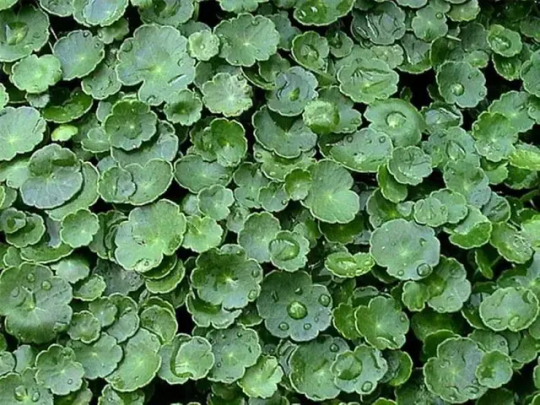
(image source)
#tumblr genetics#genetics#asks#requests#sent to me#frogtender#<- fitting#frogs#frog#plants#marsh pennywort#thank you for the silly little frogs#weird how this plant has so many common names associated with money#money plant. dollar plant. lucky plant. copper coin.#i choose to take this as a sign that you should give your frogs money. it's what they crave
589 notes
·
View notes
Note
Captain bogleech do you have handy references for the faces of mosquitos, fleas, houseflies, and ticks? I'm picking at an idea of a character who is themed around disease, and is strictly a source of disease and not diseased themself so like... Worlds best spreaders. The one I'm most locked on is miss aedes aegypti because of her good taste in stripes. SO in season (I dontactually know if stripes are in season)
Yes! First its good to know how a "normal" insect mouth is set up:
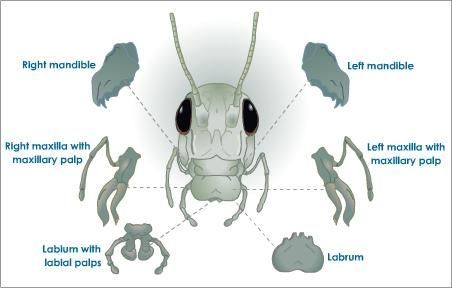
In most insects, like a grasshopper or a cockroach or the majority of beetles, there's a labrum covering the top of the mouth, kind of like a duck bill! The chompy mandibles are under that, then there are the maxilla to either side of each mandible, which include the "palps" it uses like little hands to hold food. The labium is the bottom part, and also has another set of palps! @revretch has gone into lots of detail on this but they put it best by explaining that the insect mouth is like a four sided box, formed by the labrum, maxilla and labium, with the mandibles usually inside the box. It's just that lots of insects do weird things with these parts, and many have big giant mandibles that always stick out.
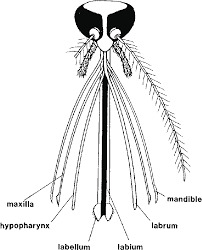

Mosquitoes have all these parts, but they're all long and thin, and they all fold together to form the proboscis, with some of them bending back as it drills into flesh.



Fleas have similar to mosquitoes, but shorter and more compact. And many species have that AWESOME looking "mustache" of thorns right above the mouth, used for anchoring to furry hosts while they feed :)

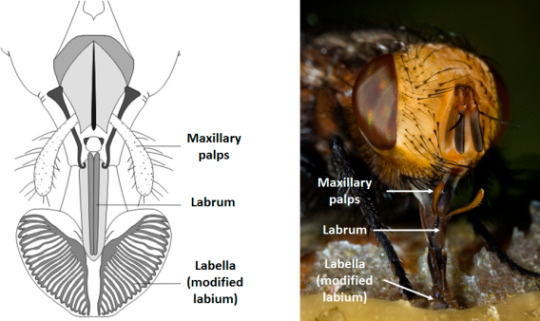
In the non-biting flies, the mandibles are GONE, the mouth extends on a flexible hose and the labella is modified into a big flaring two-lobed pad. Digestive enzymes flow down the labrum and into grooves on the pad, so it works like a sponge soaked with acid :)

Ticks are a lot different because they're arachnids rather than insects, and arachnids have fewer mouthparts; normally just one pair of palps and one pair of chelicerae, which are the "fangs" in spiders! Below all that is an arachnid's real mouth, usually just a tiny little hole. In ticks, the palps are fused into two flat flippers, which the tick uses to pinch the skin of its host. The chelicerae are formed into a pair of jagged "scissors," if the blades of scissors were on the outside! These dig in and widen a small hole. Then the mouth is surrounded by a long extension, the hypostome, which is thickly covered in sharp tiny toothlike blades. Look how rad it is:

I say this a lot but the entire part people think of as the "head" of a tick is really just the mouth, because ticks are related to mites, and in mites, the head is fused entirely with the body. So when ticks have eyes, they're here:

It's tragic the world sees ticks as fat blobs with tiny heads, when in fact they are just big heads with legs.
For fun here are some of my Mortasheen monsters that hybridize humans with all the above, though my mosquito is very dated and due for a big overhaul someday; I didn't bother trying to merge real mosquito mouthparts with fleshy human ones and just had the whole mouth spiral together:
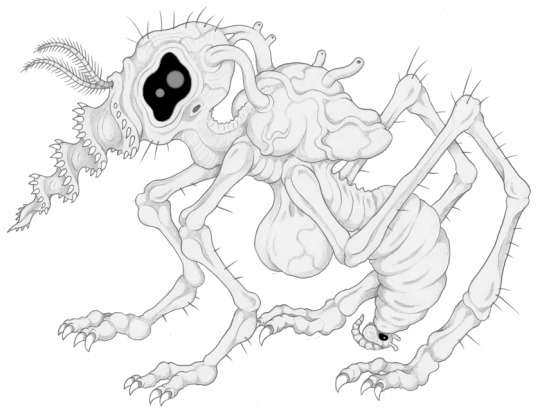
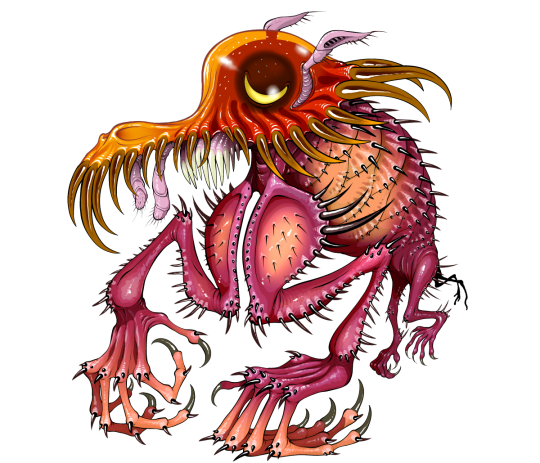



I also drew the flea without its "helmet" piece first, and went on to draw several alternate helmets :)
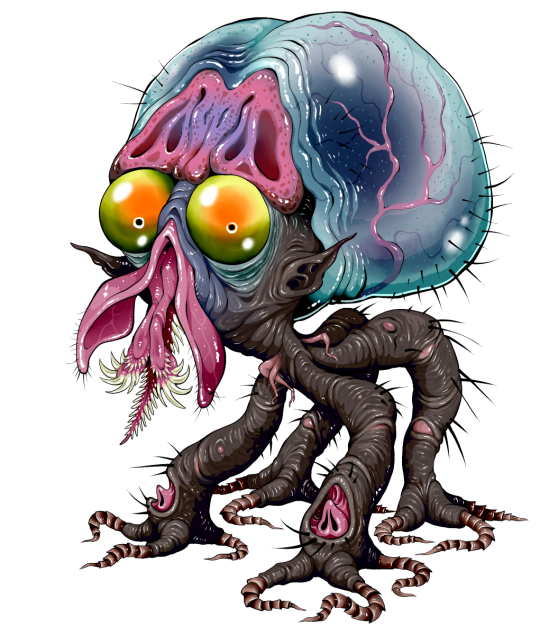
I put the most effort into the tick as you can tell. I also incorporated the fact that they smell with their front legs. :)
284 notes
·
View notes
Text
Wet Beast Wednesday: comb jellies
It's ctime for another post about aquatic critters. Ctoday I'm ctalking about the cterrific ctenophores. This ctimeless lineage of gelatinous invertebrates may hold answers about the origin of animals cthemselves. So from ctiny to ctitanic, lets go over the comb jellies to ctell their ctale.
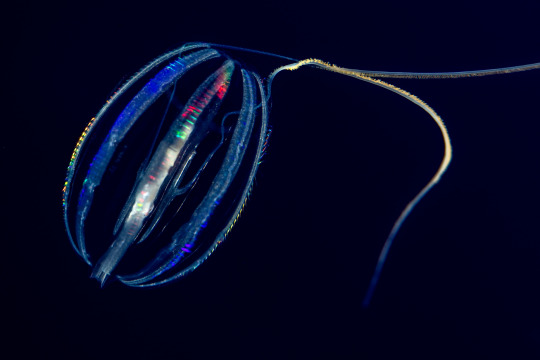
(Image: a cydippid comb jelly. It is a round, mostly translucent animal with few visible structures. Rows of combs made of cilia run down its side and appear rainbow-colored due to light scattering. Two sticky tentacles trail behind it. End ID)
The comb jellies are members of the phylum Ctenophora. There are between 100 and 200 known species. The ambiguity is because several species have been mistakenly been named more than once. That's pretty small for a phylum, but the comb jellies have some pretty diverse body plans. Ctenophores are fairly simple animals, that have some shared traits with the cnidarians, though they are not believed to be closely related. Ctenophores are round animals that, like the cnidarians, have bodies composed of two layers of cells sandwiching a gelatinous matrix called the mesoglea. One side of the body has a mouth that opens into a large internal body cavity via the pharynx (throat). The cavity acts as a stomach and connecrs to canals that run to other parts of the body. Also in the cavity are cells for reproduction, digestion, and bioluminescence. On the outside of the body are rows of cilia called combs that run from the mouth to the back. The cilia beat in sequence from mouth to rear to propel the ctenophore forward, though they can also be reverse to move it backwards. Most ctenophores have tentacles that are lined with sticky structures called colloblasts that are used to capture prey. Prey is drawn through the mouth and pharynx into the main body cavity where muscular action and digestive enzymes break it down. Unusable food is ejected back out through the mouth.
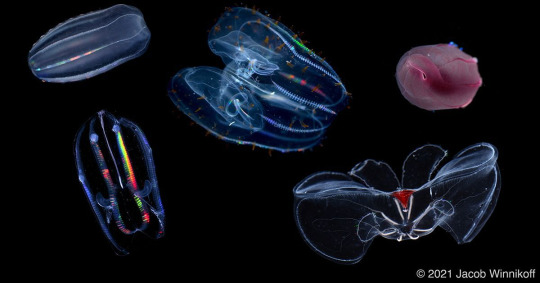
(Image 5 different species of comb jelly with different body plans. Some are rounded, others and longer and flattened, One has two large lobes, and one is splayed open. End ID)
Comb jellies have a primitive nervous system consisting of nerve nets with no brain. Unlike the nerve nets of other animals, which are connected by synapses, ctenophore neurons are fused together into a structure called the syncytium. There are two nerve nets, one focused around the mouth that controls the sensory organs, mouth, pharynx, and comb rows. A second nerve net is focused around the aboral organ, which lies opposite the mouth. This organ contains a structure called a statocyst that regulates balance and helps the ctenophore determine which direction to swim in. The nervous system uses different biochemistry than any other animal. This could indicate that ctenophores developed a nervous system independently of other animals, indicating they may be a sister group to all other animals. More on that in its own paragraph. The genome that codes for the nervous system is the smallest of any animal and may be the absolute minimum needed to have a functional nervous system.
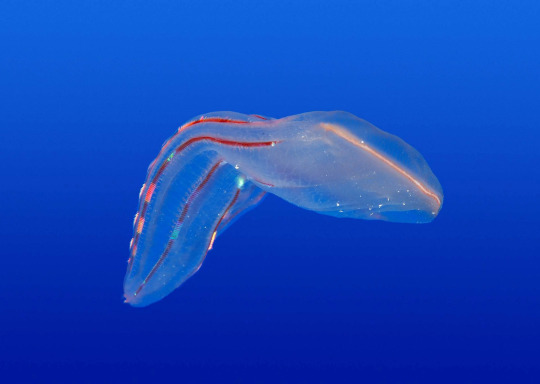
(Image: a long, flattened beroid ctenophore. Its mouth is very wide and runs along most of the front of its body, It has no tentacles. End ID)
Comb jellies have a large number of different body plans, with three being particularly common: the cydippids, lobates, and beriods. Cydippid comb jellies have very rounded bodies with a pair of long tentacles that are lined with colloblasts. The jellies drag the tentacles through to water to trap small invertebrates and plankton for consumption. Lobates have large muscular extensions called lobes that extend beyond the mouth and their tentacles line the inside of the lobes instead of trailing behind them. Cilia direct water into the lobes where the tentacles catch planktonic prey. The beroids are the only comb jellies without tentacles. Their bodies are flattened and their mouths are extremely large and line with thick cilia that act like teeth. Beroids are pursuit predators that hunt other ctenophores by either swallowing them whole or using their "teeth" to bite off chunks.
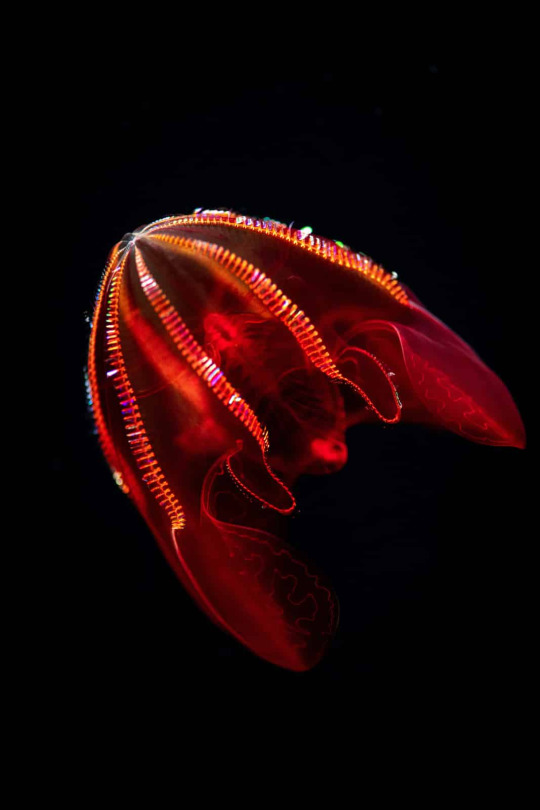
(Image: Lampocteis cruentiventer, the bloody-belly comb jelly, a lobate. Its body is red and a pair of scoop-shaped lobes extend on either side of the mouth. End ID)
Other, less common body plans include the ganeshids (who have lobes like the lobates, but the pharynx extends into the lobes and they use tentacles for hunting), the thalassocalycids (who have developed a body plan and hunting style more like jellyfish. Only one species is known), the cestids (who have very long, ribbon-like bodies and short tentacles that swim by undulating like an eel. The largest comb jelly, Cestum veneris or Venus's girdle, is one of these can can reach 1.5 m/5 ft in length), and the platyctenids (who have modified their pharynxes into structure similar to a snail's foot and live on the seafloor or in symbiotic relationships with other invertebrates. They lack combs and cannot swim).
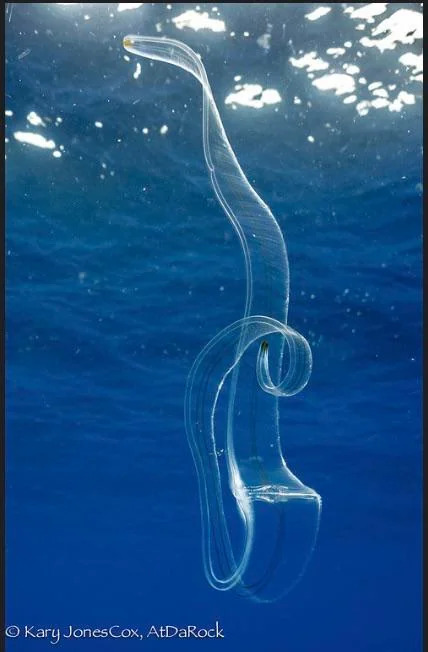
(Image: a Venus's girdle. It is a flat and very long comb jelly that looks more like a transparent flatworm than a comb jelly. End ID)
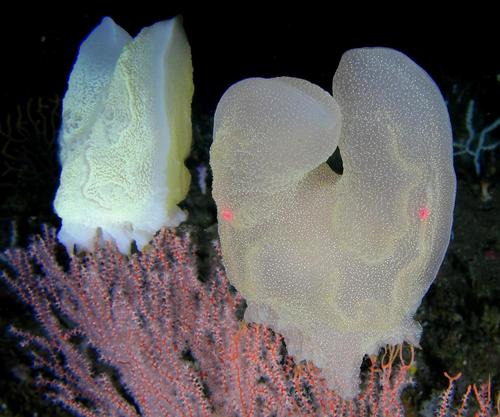
(Image: platyctenid comb jellies on a coral. They are whitish, bag-like animans with U-shaped bodies and mouths that open down and have extended organs used as feet emerginf from them. They have no combs. End ID)
Most comb jellies are hermaphroditic, with some species being simultaneous hermaphrodites (produce sperm and eggs at the same time) and other species being sequential hermaphrodites (transition between the types of gametes they produce). Three known species have evolves distinct sexes. Most simultaneous hermaphroditic species can self-fertilize. Eggs and sperm are released into the water column to fertilize. Juveniles look like miniature adults and do not go through a larval stage. The platyctenids have different reproductive behavior. Their eggs are retained in an internal brood pouch until they hatch. Juvenile platyctenids are planktonic and will go through a metamorphosis where they transition into their bottom-swelling adult forms. Platyctenids are also capable of asexual reproduction by budding off clones of themselves. Many species are capable of producing gametes as juveniles, become infertile as they mature, then begin producing gametes again as adults. Ctenophores will continuously produce gametes as long as they have enough food.
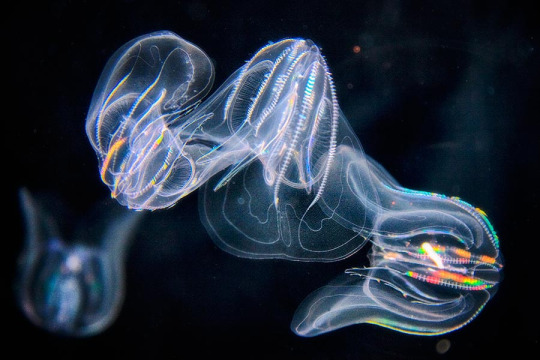
(Image: a group of lobate ctenophores. End ID)
There is some debate on where exactly comb jellies fall in the tree of life. Specifically, the debate is about how they relate to other animals. Historically it has been thought that animals were divided into the sponges on one side and and metazoans (everything else) on the other side because sponges lack certain features found in all other animals like a nervous system, sense organs, and muscles. Ctenophores were often placed as sisters to the cnidarians (jellyfish, anemones, and other radially-symmetrical animals) and bilaterians (bilaterally symmetrical animals). The placozoans (simple animals that consist of a blob of cells) were placed either on the sponge side, metazoan side, or their own group depending on who you asked. More recently, there has been a shift to grouping the sponges and placozoans with the metazoans as all being a sister group to the ctenophores. That would make ctenophores the sisters to all other animals. Genetics makes my head hurt but it appears that the data is inconclusive and there's still a lot of debate to be had. The fact that soft bodied animals like comb jellies rarely fossilize makes things harder as it means we only have a very small number of fossils to examine. Finding out where ctenophores fall in relation to other animals would answer a lot of open questions about the evolution of the first animals.
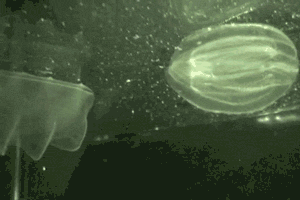
(GIF: A beroid comb jelly eating another comb jelly. The two bump into each other and the beroid opens its mouth and engulfs the prey. It then closes its mouth, trapping the prey in its body cavity. End ID)
#wet beast wednesday#comb jelly#ctenophore#jellies#invertebrates#invertblr#invertiblr#marine biology#biology#zoology#ecology#animal facts#sea creatures#informative#educational#image described
125 notes
·
View notes
Text
Well hello there, Stardust! I feel like I'm in a bit of a predicament and something tells me it's your fault。:✧˚*:・。

-Releases another dragon(adjacent) Loop into the wild-
I commissioned the lovely @nycroshears to draw Loop as a Rukemi; one of my OC species that I'm shoving in an AU I've been working on! An AU that started out as a scene that popped in my head when I was falling asleep of a rukemi grabbing Siffrin by the scruff and making them confess to their family...which turned into a massive AU I've been outlining for weeks now.
Rukemis as a species idea are nearing 20 years old at this point! I think it's past time I debut them in more than a few commissions thrown into the uncaring void of tumblr every few years. I'm not going to talk too much about them now; that'll be revealed in the AU itself!
Some more info about Rukemis + closeups below. (ISAT SPOILERS)



Fun facts about rukemis!
They're from a parallel Earth where the meteor that killed the dinosaurs glided past harmlessly.
They're descended from troodonts about 67-68mya who had a whack mutation that caused their front limbs to duplicate. They were very useless at first but others of the species found them SO ATTRACTIVE they ended up thriving and the wings over time evolved to be functional. So they are theropod dinosaurs, like t-rexes, velociraptors, and modern birds.
They evolved sapience not long before humans did after a smaller extinction event wiped out biodiversity in habitats adjacent to their native range.
Before they were relatively unassuming small tree-dwelling creatures similar to primates but with the bonus ability to fly. But with the new free real estate some of them branched out and rapidly evolved much larger sizes and intelligence comparable to our own. Now, they're roughly the size of small horses and stand about as tall as us when they're standing on all fours.
Now, parallel to our Earths, they exist a few hundred years more technologically "advanced" than us.
Their societal development was similar to ours at the start, including the destruction of their Earth's ecosystem, wars, oppression, and other fun things. But after ▮▮▮▮▮▮▮▮▮▮ and ▮▮▮▮▮▮▮▮▮▮ they mana▮ed to ▮▮▮▮ from the ▮▮▮s and bu▮▮d a ▮▮▮▮▮▮▮▮ ▮▮▮▮▮▮▮▮▮ ▮▮▮▮▮▮▮.
It was after they got their collective ▮▮▮▮ together that they gained the power to ▮▮▮▮▮▮ to other ▮▮▮▮▮▮▮▮ ▮▮▮▮▮, ma▮▮▮▮▮▮▮e ▮▮▮▮▮nts, h▮▮▮ ▮▮▮▮ds, and ▮▮▮▮▮▮▮▮ their ▮▮▮▮▮ into ▮▮▮▮▮ sop▮▮▮▮s upon ▮▮▮▮▮.
Now, many rukemis spend their lives trying to ▮▮▮▮ other ▮▮▮▮▮▮▮▮ not ▮▮▮▮ ▮▮▮▮▮ ▮▮▮▮ up like ▮▮▮▮ ▮▮▮.
Their designs were based on ▮▮▮▮ from ▮▮▮▮▮▮▮▮ ▮▮▮▮ and originally looked like your standard middle-schooler's white wolf rainbow wings + horns OC that you can see (here), but after 20ish years of workshopping they're now their own dragon dinosaur species (and are much, much gayer). This design is the most accurate and all others in the link are older versions.
They have three main sexes that are impossible to tell apart at a glance and have a much looser and queerer relationship to "gender" and family.
They generally live in family units of 3-8 adults + their children (now, often including humans and other sophonts) and have a much more relaxed & shifting hierarchy than humans generally do.
They are nice, and soft and warm.
Enter Loop, just a normal rukemi who just wanted to live a normal life as an astronomer working to discover extraterrestrial life on other planets (because finding life on parallel Earths just wasn't cool enough for them). After an ▮▮▮▮▮▮ by a ▮▮▮▮▮▮▮▮▮ ▮▮▮▮▮▮, they were thrown into the world of SASASAAP and eventually runs into Loop Siffrin struggling through their time loops all alone.
Originally, I created a random rukemi to aid ISAT Siffrin through the loops and join the family after they broke free of them. But after developing it for a while I realized I had no idea what to do with Loop so I just fused the two into one and tossed them into the Start Again world to help OG Siffrin instead.
(Sorry y'all, this Loop doesn't sparkle as they are made up of flesh and blood and not pure craft energy. They did get some cool "tattoos" some time before coming to SASASA:AP world looking like a celestial being, though! They look like the 2nd image to Siffrin. If they had more time they might found some glitter to make a more theatrical entrance.)
-Adds another "dragon" Loop to the pile-
#isat#in stars and time#isat loop#isat au#rukemi#dragon loop#my shitposts#sasasap#sasasaap#sasasaap loop#isat spoilers#sasasaap spoilers#art by nycroshears and some tweaks by me#because i didn't want to waste 5 hours of their life making them do tiny experimental changes for me fhaiewufh
101 notes
·
View notes
Text
WASP REVIEW - BEES (MINECRAFT)

[Image ID: An official render of the Minecraft bee /End IDs.]
Alright y'all, it's time for an iconic one. One of the most common of only a small handful of arthropods in the game (ironically given the fact they felt the need to specifically make Bane Of Arthropods a thing), and the least hostile one at that, these blocky bees have deservedly buzzed their way into beloved status amongst Minecraft players over the past five years since their official debut. However, as I'm well aware at this point in this series, popularity does not necessarily mean accuracy, so how do these insectoid cuboids really stack up?
Starting from their appearance, it's obvious is that their bodies are heavily fused, with one solid body segment. I'm sure you don't need me to tell you this, but nevertheless, the body of a bee is notably more segmented than the body structure of the Minecraft bee, having three body segments: The head, the mesosoma (also referred to as the thorax, though these are classified a bit differently), and the metasoma (also referred to as the abdomen, same thing here as with the mesosoma). This is clearly a stylistic choice, so I can't get too mad at it, but it is disappointing, given the fact that Minecraft's spider is more segmented, perhaps even having more body segments than the real thing.


[Image Sources: iNaturalist, Yuriy Danilevsky, and PBS, Nebraska Public Media | Image IDs: A photo of a black and yellow/orange European honey bee feeding from a yellow flower, followed by an illustration of a honey bee (female, worker) showing its body parts as labelled. Mandibles, antennae, eyes, thorax, abdomen, stinger, foreleg, middle leg, forewing, hind wing, and hind leg (with labelled pollen basket) /End IDs.]
That said, there are some other things I take issue with regarding this design apart from just this choice of segmentation. I feel like it's safe to assume this bee is based off of the most common honey bee species, the European honey bee (Apis mellifera), in which case, they honestly feel like they're a bit too wide? This wouldn't be a big deal, except, I feel that if they were a bit longer it would help keep the proportions from feeling kind of... Off- Even if we do simplify a bee down to one continuous body segment, it helps to have some distinctions made between the areas of the body. The way they've done it here almost makes it seem as though the mesosoma is just straight up not there; Like the head goes directly into the mesosoma with no in-between.
Another thing that would help this design to not feel quite as "fused together" would be a slight change in coloration. The Minecraft bee has a yellow head, which goes directly into the stripes of the metasoma a little further down the body. In a lot of real world honey bees, the head and mesosoma are generally darker and more solid in color than the lighter and/or more vibrant stripes of the metasoma (with some exceptions), varying in shade depending on the amount of fur (the length of the setae), from a muted yellow to a dark brown color; Further still, honey bee heads can also be noticeably darker overall than the mesosoma at times. Taking this into consideration, I would make the Minecraft bee long enough proportionally to fit another pixel or two lengthwise—enough to provide slightly more space while also not being too long—making the area representing the mesosoma a slightly darker yellow, and the area representing the head the same color as the brown stripes on the original design.
But enough about the body segmentation! Let's talk about the smaller details for a minute here. The wing count is wrong, with only two wings as opposed to the four of a real bee, and they're lacking in terms of venation. The leg count is right but the proportions are all wrong, and they suffer from the same issue as the body, where they look completely fused together. I completely understand wanting to simplify this aspect of the design, but going from five major segments (Coxa, trochanter, femur, tibia, and tarsus) is kind of ridiculous!

[Image Source: bugguide.net | Image ID: An illustrated diagram showing the legs of three Hymenopterans, the first two being of other wasps, while the last one is of a bee, with each segment labeled. Coxa, trochanter, femur, tibia, and tarsus, with metatarsus on the bee. /End IDs.]
The antennae themselves are alright, if a bit short; I appreciate them having little pixels on the main body where they connect to the head, but yeah, it would've been impossible to give them much detail at all at this resolution. The position of the antennae, however, is what throws things off, as they're placed above the eyes when they should be placed between their eyes. Speaking of! Their compound eyes are FAR too small, they should reach up and around the top of their heads, while the eyes here reach only about the halfway point of the texture; and to add insult to injury here, they don't even have their three ocelli (simple eyes)! Nor do they have any mouthparts to speak of, which is an even more major thing to be missing for a bee!

[Image Source: Arizona State University | Image ID: An illustration of the head of a worker honey bee with mouthparts extended, the whole head labelled as follows; Compound Eye, Ocellus (one of three), Antenna, Labrum, Mandible, Maxilla, Labial Palp, Proboscis, and Glossa /End IDs.]
In the end, there's not really much left to cover in regards to this design just due to the fact it's so simplified, though I will say one last thing about it, for now; Their stingers shouldn't be out like that 24/7. Some of their relatives DO have their ovipositors (same thing, a stinger is an ovipositor that can also inject venom) out on the regular, but not bees.

[Image Source: mchoneybeev | Image ID: An in-game screenshot of two Minecraft bees in a cherry forest /End IDs.]
Ok so, what about their behaviors, then? Well, honestly, I think these are actually some of the more accurate ones I've covered in terms of behaviors in this series. Unlike many previous reviews, Minecraft actually goes through the effort of showing that these insects visit and pollinate flowers; Which, barring the ones that are explicitly aliens or robots, would be the case for every Hymenopteran we've covered in the real world. Now, pollination in Minecraft doesn't have an effect on the flowers themselves, it certainly affects the bees!
After visiting a flower, the bees will return to the hive, supplying the hive with honey, as well as beeswax in the form of honeycombs. While this happens much quicker and in larger quantities per trip in the Minecraft bees for purely mechanical reasons, this is relatively accurate to the honey bees of our world, which produce honey from the sugary nectar of flowers, in turn producing more wax as well as they process various bits of plant matter.

[Image ID: An image of a nest made by bees in Minecraft, in the state in which it is full of honey /End IDs.]
We don't actually see these processes happen, however, which I'm sure is partially, fairly enough, because they didn't want to animate it, but it's also because their nest is an enclosed arboreal nest! Bees of the genus Apis primarily prefer to nest in sheltered locations, so the enclosed nature of their nests isn't entirely inaccurate; When they can't find a hollow log or something of the sort, they'll even nest out in the open in the branches of trees. However! These open air nests are exactly that, open! In the instances that they make their hive in the branches of a tree, they will actually make it in a structure that is entirely exposed to the elements, in slabs of honeycomb with no protective outer walls. It's also, perhaps, because of this enclosed shape, and the sheer scaled-up size of the bees in Minecraft (Roughly 0.56 meters if you go by the 1 block = 1 meter measurement) that these nests can only fit a measly three worker bees compared to the upwards of tens of thousands in a real colony of honey bees.
There are actually social bees, though, that produce enclosed nests, made of wax, out in the open, in trees—even producing honey. They're in the same family as the honey bees we know and love, in fact! However, these ones are a part of the genus Trigona, whereas the common European honey bee belongs to the genus Apis.

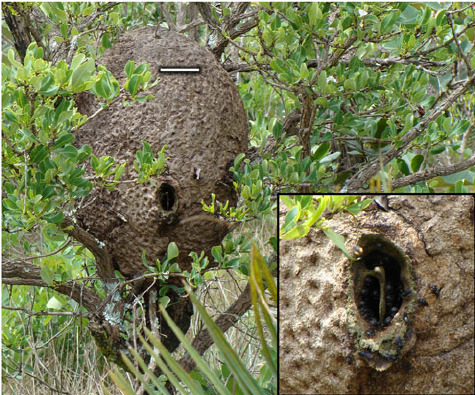

[Image Sources: iNaturalist, Kahio Tiberio Mazon, ResearchGate, Multiple Authors, and AJC, Tim Thompson | Image IDs: A photo of two black and red bees of the species Trigona spinipes on a yellow flower, followed by an image of a nest in a tree made by the same species, followed again by an arboreal nest made by a bee species within the genes Apis, showing how the honeycomb is shaped into slabs exposed to the air /End IDs.]
Some other things we don't seem to see in Minecraft are the queen and drones of the hive! Perhaps understandably so, as queens don't leave the hive many times throughout their lives, and the drones mainly leave the hive to mate with queen bees, along with the fact that there aren't as many drones and queens in a nest as there are workers! This does also further confirm, on top of the presence of their ovipositors, that all the bees we see in minecraft are females! It would be quite fun to see how they would translate the eyes of a drone into this style, however.
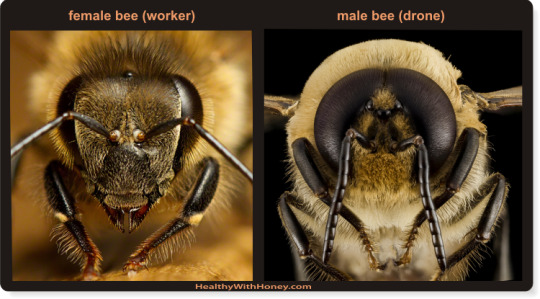
[Image Source: Healthy With Honey | Image ID: A close up set of photos that shows the differences in facial structures between a female, worker bee and a male, drone bee /End IDs.]
Again, on the topic of those ovipositors (I.E., their stingers), how do they attack? Well, thankfully this time there's not anything fantastical about their attack patterns, as they simply sting the player when provoked. Which is another thing! They only attack when provoked; when their hive is attacked, when they're attacked, or when you attempt to harvest from the hive without taking the proper precautions. I feel like this strikes the right balance between being dangerous if messed with and also not being "aggressive", once again unlike many other depictions of Hymenopterans in media in general, as, usually, you get either complete pacifists or murder machines fueled by anger.
Furthermore, when these bees sting you, they take another cue from their real world counterpart and actually lose their stinger! Most bees, ants, and other wasps that are capable of stinging are also capable of doing so more than once; Famously, though, honey bee workers will, more often than not, get their barbed stingers caught in the skin of things like mammals, and lose it. Understandably, Mojang did not depict what actually happens when they lose their stinger, as this leads to the partial disembowelment of the bee, thusly causing it to die.

[Image Source: PBS, Rose-Lynn Fisher | Image ID: An image of a honeybee stinger magnified 650x /End IDs.]
As I mentioned in passing a minute ago, you can, however, absolutely harvest from your hives without aggravating your bees—which doing so could end up potentially killing both you and your bees. With the power of a campfire! And no, of course I'm not suggesting that you burn your bee nest, since, as it turns out, the bees are calmed by smoke! Another well known fact due to the process of beekeeping, as beekeepers usually use smoke to calm bees. I would not necessarily recommend the campfire method, though, as it might be a bit too much in general, and may be a bit too hot for the bees. Even still, relatively cool smoke, applied in just the right amount as to be completely safe for them, will mask alarm pheromones and suppress bees' sense of smell, in turn suppressing their alarm response.
Fittingly, this isn't the only aspect of beekeeping carried over into the Minecraft world, as bees can also be moved from their natural hive into a man-made box hive!

[Image ID: A render of the wooden beehive from Minecraft /End IDs.]
Not much to say here about the structure itself here, as it's made by the player rather than being made in nature. Sadly—and logically due to their equal size—this structure cannot contain any more bees than the natural hive can, however, it still remains useful as the easiest way to move bees from one place to another. That said, I feel it necessary to mention; Due to the fact that, again, we never see a queen, this implies that either these bees have a social structure that is quite different from the real world, or that these bees are leaving their nest without their queen, which would be highly disadvantageous for the colony as a whole, as the queen is the only fertile female! You can even get them to leave individually, which is highly strange behavior for a honey bee. If brought away from the nest, a singular worker bee will typically not attempt to make a new home, and instead try to find a way back to its original home and its queen.
One final thing I want to bring up is that... You can put bees on leads! In fact, this is a major way of bringing the bees from a natural hive to a wooden one. This would be highly impractical in real life, however, it is very cute!

[Image ID: A screenshot of a Minecraft bee on a lead /End ID.]
With everything out of the way, we're left quite a few aspects that are accurate to the real world, but some strange inaccuracies all over the place as well. I find the design to be one of the least accurate among those I can directly compare to the real world, but certain aspects of their behavior, as well as the care put into including certain details, redeem them somewhat. Still, their behavior does contain some inaccuracies as well; So, these blocky bees get my accuracy rating of-
-
Overall: 4.5 to 5/10
-
Leave your wasp review suggestion in the replies, tags, or askbox!
55 notes
·
View notes
Text

Sundyne fullbody
2nd to last, the big nasty bug lizards!! (Aka sundyne, if you dont want to get kicked across the room)
Here's the evil exposition dump:
Sundyne are under the Cerest label umbrella with Dorest and Rox, but are genetically distinct enough that they aren’t really the same thing.
It’s a commonly held theory among other species that they’re some kind of artificially created Cerest offshoot that went wrong and overtook their creators, but that’s crazy talk and bringing that up around a trad Sundyne is a great way to get snapped at.
They share some things with their Drecu cousins and I would suggest reading their stuff to get the general vibe, but the gist is that Sundyne also have serviceable but poor temperature regulation, their eyes aren’t spherical and are housed in bony cones in their heads, they can see colors that we can’t, they lay eggs and have a similar life stage development cycle,they have extremely sensitive antennas, and they have a mix of endo and exoskeleton/shell.
Their differences are a lot more distinct (obviously) Sundyne are obligate carnivores, for one, and have a lot harder time processing plant matter than Drecu. Their lower mandibles and beak are very sharp and are used to both tear into and hold prey.
When their mouth is closed, these two are pressed together tightly by internal muscles. Along with their little bit of lip and their other mouthparts that fold closely along their face, it gives the impression of their jaw being more like ours (especially when I stylize it and remove all detail >: ) ).
Those internal grabbies are about as strong as a human thumb, and are used to make speaking noises by vibrating them together along with the apparatus in their throat. Those also help to hold/maneuver food without opening the mouth too much (which they see as a threat)
Another difference in their mouth is their tongue, which is housed in a hole along their lower jaw, and its length retracts down their throat.
They use it to strip meat from bone and lick yummy goop out of shell and bone holes.
Their huge eyes function much better at night, and they usually keep them lidded to avoid sensory overload or looking like theyre upset (again, their eyes aren't full spheres in there, and instead are more like weird cylinders that taper as they go back in the skull.)
Like Dorest, all 6 of their fingers on their main hands are separated, though now they are all much larger and longer (at least on this top pair of arms).
Only the claws on their larger top arms are retractable, operating by sliding in and out of a pocket of endoskeleton in their end knuckle.
The smaller bottom arms have a thumb claw like Rox, and none of the shorter and duller on the other fingers are retractable.
Also like Rox, they have a special claw on their foot for kicking stuff, though theirs is much more pronounced and mobile (their other toes are relatively short and also have retractable claws.)
Male Sundyne also have a third pair of 'limbs' that are actually gonopods that fold on their back that they use to carry eggs, another indicator that their genus as a whole may have once had 8 limbs that have since fused or retracted.
Speaking of male, sundyne are not hermaphroditic, with *adults* being distinctly male or female. It's impossible to tell until the first molt after pupation, though.
Sundyne dimorphism is based on this sex difference and it decides their service role in their familial/ societal clans (rather than with Drecu, whose role in the colony decides their sexual role)
Their family units tend to be single dominant reproductive male and female pair, their children, and nonreproductive members.
Traditionally, that dominant pair is decided by whichever is the strongest female and whichever male catches her attention, but modernly and in higher classes there is a lot more linking of clans and inter/extra political and legislative to consider.
The dominant male and female are monogamously bonded, but often switch their single partners a lot for politics etc (though long-held bonds are seen as better) nonreproductive members can have multiple partners and do, but the privilege of eggs is only for that special pair bond.
The closest thing from earth i can say is they're structured a bit like a lion pride or meerkats, though females are the ones who defend the territory while males hunt and rear children once the eggs have been laid/hatched (which is where Rox and Dorest got their child raising roles from)
In any clan, females outnumber males because at a certain age most males are meant to leave and go join another clan. Because of this, the nonreproductive females often assist with resource gathering/some ither male roles (though they're given their own pronoun for this since males are their own special thing)
Males are smaller in height and sleeker, and have more markings on their face/ body (while they look very flashy to us, it helps break up their shape to their colorblind prey).
They also retain one more set of limbs than females: gonopods like Drecu on their back that also help hold their females eggs in place (once the female is ready to lay them, they give them to the male with an ovipositor) .
Females are much larger and more muscular, with fewer markings but often more impressuve crowns of horns. They also don’t have the same external genitalia structure.
The horn things on a female will drop and regrow more based on hormone signals from their social status and/or their environment. On a male, they will not (but they do keep growing constantly)
I keep saying "things" on their head because they're structured sort of like horns but not quite.
Theyre more or less hollow/spongy bone on the inside with a thin sheath covering , more or less permanent, and sort of vascularized and growing for the whole year. BUT they can branch, don’t have a single living core, and they can drop and regrow if damaged enough by the root (kind of just a spongy thing growing out of a bone shoot idk).
Horn damage on a male is seen as extremely unattractive and disgraceful (the long continually grown unbranched ones are the beauty standard since it exemplifies how precious they are)
Females use them a lot more for combat, territoriality, and social status (whereas males use them for defense and social status) so they get cracked more often. If this happens, theyll regrow with some deformation around the sheath. If they get access to a better food source, they’ll also drop and then regrow better and stronger (but smooth and with no tines). For the few reproductive females, they will shed and regrow bigger/stronger horn things with more branches yearly the longer they’re the dominant female as a status symbol. Any horn branches are looked at very favorably on females, but the crooked/unnatural spurs and bumps caused by damage is looked at as a low status symbol since the only reason they’d still have it is if they aren’t dominant enough to get the signals to drop and regrow them the right way.
As for their life cycle, its a lot like Drecu. Egg, little gloopy grub thing, bigger goopy grub thing, prepupa, chrysalis, juvenile adult stage.
However, during pupation adults can’t ‘choose’ the final form of their offspring like Dorest and Rox can. Males are considerably more favored because they leave their home clan to build ties and status in other clans, ultimately expanding the influence of the family and more freely rising in the ranks (they leave, marry in with a female of equal or greater status, and can move up by taking out other males there. a female doesn’t typically leave their birth clan, and could never become the dominant female of their own clan because incest and patricide taboo, and the only way they’d be able to in another clan is if they enter as a nonreproductive and maybe get lucky enough that the dominant female falls out of favor so you can yake her place)
If they had the chance most clans would cull many of the females in their clutches, but since they can’t tell the difference until the age where their kids are legally considered people, it’s harder to do that.
Succession rites for females follow a matriline from the dominant female, but they have their own internal pecking order established through literal and social pecking. If you’re a better fighter or just smarter/more useful, you’ll have a higher status. But if you were born in that clan, you'll never be the dominant female unless the male gets taken out of the equation too, making an opening for a new leader.
Males get their initial status from their pair with a female upon entry to a new clan, but they can actually move up to the dominant position by killing or otherwise removing the previous male. After this, they can choose a new female.
Their biological roles of hunter/nurturer for male and protector/fighter for female translates to their modern sociopolitical roles pretty literally. Males hold power as lawmakers, media makers, educators, and leaders due to their more 'intellectual' domestic role and ability to bridge clans in alliances.
. Though they are physically superior, females become the males protection once they are paired. They hold power within a clan and often in the military or as lower government officials, but outside of the clan their reach is pretty much carrying out and enforcing the orders of their male.
Their dynamic is like a sword and its wielder, or a speaker and their voice, though it is also referenced in their own culture as a male/female pair being “the sun and its moon.” They also take great pride in this binary, seeing it as something that sets them apart/ male and female completing each other to form the perfect whole.
Straying from this is a one way ticket to being either kicked out of the clan, jailed, or killed depending on where you are and who you’re dealing with.
They will enforce it onto any other species they meet (which is part of why Dorest and Rox are rigidly separated by a gender role along with their biological role in the colony, even though they are both sexes)
Sundyne clans are at the tippy top of Cerest society’s order (wirh Seru being the tippy top of the Sundyne exclusive caste, represented by a circle). They oversee their Drecu colonies and use their resources and manpower to expand their territory. This hierarchy is deeply entrenched, with any Drecu within a trad Sundyne structure believing that the Seru are immaculate and powerful beings.
Another conspiracy theory is that back in the early days of Sundyne development they probably preyed on Drecu and infiltrated their colonies through pheromone manipulation, overtaking that territory for their clan. The pheromone thing allows them to influence the general emotions of Cerest around them and give loose instructions, and to stop the instinctive swarm swarm swarm kill kill kill responses Drecu get when they see them (To Drecu, Sundyne look like creepy elongated nightmare versions of themselves, and though this response has largely been bred out most Dorest and Rox still feel an uncanny effect from looking at them. ) again, that's crazy talk though and never happened.
One more to go, and its the funny parasite worm ones
#Cerest#Drecu#Sundyne#pleas ask me questions please oelsease please#this was fun to make but sometimes i feel i dont connect the dots when writing it all out so if you actuakky read all this and notice#any discrepancies or stuff tou dont get please ask meeee#love these guys. horrid neon raptor people AND theyre every kind of phobic and ist there i#alien species#original species#drawing#spec evo#worldbuilding#speculative biology#xenobiology#very excited to share my sundyne character too i hate her she sucks so much
67 notes
·
View notes
Text
Humans rig stuff together
The battle had been close. The Gren Warfinder had completely surprised them. They flipped nearby on a stolen drive and had started pounding the convoy. They were clearly trying to cut supply lines to the Colony in an attempt to starve them into surrendering. More than half of the ships in the convoy were destroyed before the Coalition was able to mount a response. Iixan was thankful that their ship was only mostly destroyed instead of completely destroyed. The Coalition dreadnought could waste no resources to repair though. They offloaded the cargo, handed out a case of multi-species ration bars and said that if the crew couldn’t fix the ship, someone would be by in 30 solar days or so to rescue them. With a ‘luck be with you’ they flipped away, giving chase to the Gren.
Iixan was ordered by the captain to assess the damage. The hull was holed in at least five places and two of them were too large to patch. They were going to be in suits for the duration. That was frustrating, but survivable.
What wasn’t survivable was the fact that two of the three reactors were offline, with one of them reduced to slag. Iixan found himself next to the non slagged reactor with the three human crew members standing over it. They stood around the reactor, one with their hands on their hips. Iixan didn’t know much about human body language, but they knew that pose was an important one.
He found their comm channel and clipped in. “…I’m telling you, we can just do a hard restart with something in place of the fusion fuse.”
“That’s insane. The fuse exists for a reason. If we let the field get too strong then the whole thing will collapse.”
“Is it better to have a rickety reactor and be able to Flash home, or no reactor and sit here, cold in our suits, eating-“ here the human shuddered “-multi-species ration bars for a month while we wait for the Coalition to remember we’re stuck out here?”
“Okay, wait. Maybe we can split the difference. What if we- oh hey Iixan! What’s up?”
At the mention of his name, the three humans turned to face Iixan. Their suits were bulkier and armored where his was just barely a skin of synthcloth and a helmet. He always wondered why human suits always looked like battle armor. Their large bulbous helmets were clear now, but they could be completely blackened, or even mirrored when necessary. Iixan always felt a little uncomfortable when multiple humans turned to give him their full attention. “Uh, Commander Mizzen asked me to do a damage assessment.” He peered around the humans at the three reactors. “Looks… bad?”
The first human nodded and gestured towards the pile of melted metal, still smoking slightly. The light of a nearby star shone through the smoke, giving it a pretty effect. “Reactor three is toast. There’s no fixing that one. Reactor one is offline with… minor damage. Reactor two is online and keeping us alive for now. We’re trying to decide if we can rig Reactor one to work enough to Flash home.”
“Rig?”
“You know” The second human shrugged in their suit. “Make it work enough to get us somewhere. It’s not fixing it, not really. Just like pretending it’s fixed to the point where it doesn’t realize it’s broken and it’ll run until it notices that it’s actually broken.” The other two looked at him and he looked embarrassed. “Figuatively that is.”
Iixan’s upper arms crossed themselves and made a motion like rubbing warmth into his arms. “And that works?”
“It’s a little more than pretending it’s going to work.” The first human sighed. “We can get it going, but it won’t be pretty and it probably won’t be… that safe. I know your sapient group is more sensitive to high magnetic fields and the reactor is going to be… leaky so you should probably tell the captain to keep the reactor hall humans only if we get it running.”
“You’ll be all right?”
The third human had a strange lilt to his speech. Iixan asked once and he said that he grew up in a place called ‘Minnesota.’ “Oh yah, it’ll be fine, but doncha know, it’ll be a mite dangerous for everyone. No worries though, we’ll make it work enough to Flash.”
The first human nodded. “Come back in a demicycle Iixan, you’ll see.”
Iixan completed his survey and reported to the captain. While he was out, people were able to seal some of the smaller holes to the point where you could take your helmet off in a few rooms. That would make eating easier at least.
One demicycle later, and Iixan returned to the reactor hall. The slagged reactor was in even more pieces than he thought possible, and Reactor one was partially disassembled. Iixan swore that he saw melted parts of Reactor three wired into the reactor. When he clipped into the comm channel they turned. “Oh Hi Iixan! We’re just about ready to test.”
Iixan pointed at the parts. “What are the… melted parts?”
“Oh, that was Will’s idea. We stole some of the… less melted parts from Reactor three to try and kick Reactor one over. They’re not exactly the same model, but I think it’ll be close enough. Just had to put in a few bodge wires in to get power and signal where it needed to be.”
Peering closer, Iixan saw that there was nearly an entire plain’s worth of wires roughly soldered into different parts of the reactor, crossing back and forth and across. The Reactor looked utterly broken. He looked up at the humans. “This… will work?”
Will smiled. “One way to find out, right? We’re going to force a hard restart and see if it’ll work. Tell the Captain to get ready, okay?”
Iixan made a gesture of supplication to the Machine Spirits and called the Captain. The Captain was just as dubious as Iixan was, but agreed to let them try. He signaled Will and the other two and they made that odd gesture of theirs where they curl their large fingers together except for their shortest one and stick it straight into the air.
“Here we go!” Will reached deep inside the Reactor and flipped some switches that were added while they were bogding.
After Will flipped the levers, the three of them jumped back almost as if they were injured. Iixan took another step back as the reactor spun up. The reactor hall had no atmosphere so he coulnd’t hear anything, but he could feel it. It had a thrumming vibration that was getting faster and faster. Iixan wasn’t a reactor technician but even he knew it didn’t sound right. The thrumming was… off balance somehow? It also sounded rougher? Still, the vibration was more and more intense until it felt like the grated floor was a shake table moving them around.
Suddenly, there was a prismatic flash and a shaft of pure white light shot out of the reactor towards the back wall. The humans jumped back and one of them reached towards a bundle of wires that was draped on the floor towards a wall when Will shouted “No! Leave it! We knew containment might leak. It’s otherwise holding steady. Let me refactor.” Will glanced down at his pad and furiously typed and slowly, the white beam faded.
It felt like the room would shake apart, and the reactor blurred in Iixan’s vision in a disconcerting way, but it was running. Will and the other two bounded up to Iixan. “That’s as good as we’re going to get it I think. It’s running at around 74.8%. If we run Reactor two at 112% We should be able to Flash home. We’ll have to stay in our suits, but that’s a sight better than hanging around here.”
The Captain was stunned when Iixan told him and demanded to see for himself. He was led to the Reactor hall but Will had warning him not to enter due to the danger. He stood in the open doorway watching the Reactor vibrate and blur as Reactor two ran with yellow and orange warnings all over the indicators as it was… gently overloaded. “Ancestors. You got it running.” He looked at Will. “How?”
Will demurred. “Oh, just a little bit of experience with these kind of Reactors and a human willingness to rig up a temporary solution. If it’s stupid and works, it’s not stupid.”
The Captain met Will’s gaze. “No. It’s still stupid. But right now we need some stupid. Well done. Now pardon me, I need to get the calculations to Flash home started before that-“ he points at the rigged reactor “-fails and traps us somewhere even worse than here.”
#humans are deathworlders#humans are space orcs#sci fi writing#writing#humans are space oddities#jpitha#humans and aliens#humans are space capybaras#humans are space australians#FlashWarp
295 notes
·
View notes
Note
it must be hard for izutsumi being a mixture of a social species and a solitary species
Cat's aren't necessarily a solitary species! Can't speak for the monster that was fused to Izutsumi but house cats are more "socially flexible" and they can benefit a lot from having another cat friend, that's why some specialists say you should adopt two kittens instead of one. They'll play together and overall behave better with a friend and might even be easier to care for than a lone kitten (but ofc if you already have one cat don't just introduce another all willy nilly or they'll hate each other)
Anyway cat rant over, I think Izutsumi is more akin to a feral cat, she doesn't trust people because she has been hurt so many times before, so she has to learn to be social again. I think her past trauma is probably the hardest to overcome.
Although I guess people that are way too touchy do annoy her LOL, she has that "I'll snuggle up to you but you cant snuggle up to me" cat attitude
#ask#optimisticdogcollector5#Izutsumi#please forgive that sometimes I go on animal rants especially if its about cats#It's my Laios side
114 notes
·
View notes
Text
Plural/System Guide!
Hello! We wanted to share a quick plural guide for anyone that is confused about plurality.
(This guide mentions dissociation quite a few times, so you may also want to check out our dissociation guide. We also recommend you read our alterhuman guide, to understand experiences that non-humans & introjects within systems may have.)
------
Plurality/Systems is an umbrella term for anybody that has more than one person/entity controlling a singular body. Each member can have their own name, pronouns/titles, sex, gender, appearance, race/species, orientation, etc. Anyone that isn't plural is a Singlet.
Being in-control of the shared-body is known as Fronting. Fronting can be optional or forced by the brain. Co-fronting is when multiple people are fronting at the same time. If a fronter/co-fronter cannot retreat, it is known as being Frontstuck. When a system is swapping who is fronting, it is known as Switching.
System members are called sysmates, headmates, alters, parts, or facets. Every system has their own preference of what to call their members. In some cases, sysmates are temporary, and may go inactive/fade over time, or exit through a gateway (more on that later.)
Sysmates can have individual memories, or they may share all their memories as a collective. They may or may not get the choice of what to share. If a certain memory is not accessible to all of the system, it is known as having Amnesia Barriers.
An Innerworld/Headspace is a dreamscape that many systems have, where members can live and interact when they are not in charge of the shared-body. They could have one set appearance (ie; a planet, a spaceship, a house, etc), or they could shift/change, either randomly, following a schedule, or at the will of sysmates (either specific sysmates or all sysmates.) The opposite of the innerworld (the physical space that the shared-body interacts with) is known as the Outerworld/Meat Space.
Many innerworlds have fronting rooms, which are areas that sysmates go in order to watch what is happening in the outerworld.
Not all systems have a innerworld. They may simply go into a "coma" when they are not fronting, or may "float" in an empty void. Innerworlds could be any size.
Some systems have NPCs (people who are incapable of fronting & engaging in shared memories). NPCs can be simple (repeating lines, repeating tasks, limited behaviors, etc) or complex (capable of new dialogue, capable of coming up with new tasks, a variety of behavior, etc). For complex NPCs, the only way to tell them apart from sysmates is by the fact that they have no special abilities (like fronting, sharing memories, or set-roles.)
Fragments are sysmates that are not fully developed. They are sort of in-between simple NPCs and sysmates. They have some system capabilities, but are not fully autonomous, and often to not have a full grasp over their personal identity.
Sometimes NPCs and fragments develop into full-sysmates.
Fusing/Merging/Integration describes when two or more sysmates merge together, either temporarily or permanently. If it is a temporary fuse, it is known as Blending. Their physical appearances may combine, or they may take on only one of the sysmates appearances, or a whole new appearance unrelated to either of their previous ones. Their identities may be merged as well, or they may be autonomous within their innerworld body; a system within a system.
Subsystems are systems within systems. They might be a result of fusion, or they may have formed as subsystems from the start, or developed their own sysmates unrelated to fusing.
Some systems have groups that live separately within the headspace (usually on different layers of a headspace). These are known as Side Systems. There may be a Main System (which consists of the people with the most control over the shared-body), or the system may be made up fully of side systems that have equal control over the shared-body.
Here are a few terms for sysmates:
Little/Syskid: A sysmate who is a child, typically under the age of 13. Middle/Systeen: A sysmate who is a teenager, typically 13-17, however sometimes 18-19 is included. Big/Biggin/Sysadult: A sysmate who is an adult, typically 18+. Ageless: A sysmate with no age. They might look like a kid, teen, or child, or they may have an ambiguous appearance. Age-Slider: A sysmate whose age is fluid/fluctuating. How frequently their age changes depends on the individual. Lost Adult/Disadult: A sysmate that is physically an adult, but mentally a child or teenager. Claudia/Paradult: A sysmate that is physically a child, but mentally an adult. Exomemories: Memories that did not occur within the shared body or innerworld; memories from a life outside of the system. This can apply to introjects & walk-ins. Exotrauma: Trauma that did not occur to the shared body or within the innerworld; trauma from exomemories. This can apply to introjects & walk-ins. Introject/Introtive: A sysmate who has a specific "source." For example, a sysmate who forms with the appearance and/or experiences of a fictional character or family member. They may or may not share the personal identity (name, gender, etc) of their source, and may have exomemories/exotrauma of their source. Fictives are introjects with fictional sources, and Factives are introjects with real-life sources. Core(s): The first/original sysmate(s) to exist within the system. Gateway System: A system with a gateway (either physical or metaphorical) that leads to other spaces, such as other layers of the innerworld, or into a different universe. This gateway may be a one-way walk (as in once someone enters, they cannot leave; or vice-versa) or it may be free range both directions. If a new sysmate enters a system through a gateway, they are known as Walk-Ins. Median System: A system where sysmates are not as distinct from one another, and are "blurred" or are simply "different versions" of one main identity.
------
Origins
Next up, system origins.
Adaptive System: A system that was formed in order to cope with something. This includes traumagenic, stressgenic, isolgenic, neurogenic, and physiogenic systems. Traumagenic: A system that was formed due to trauma. Stressgenic: A system that was formed due to stress. Isolgenic: A system that was formed due to loneliness or social isolation. Depending on how strongly the loneliness affected the person, it may also count as traumagenic. Neurogenic: A system that was formed due to pre-existing neurodivergence. For example, an autistic person who developed sysmates of characters from their special interest. Another example would be a person with substance abuse disorder who developed a sysmate to help them overcome their addiction. Physiogenic: A system that was formed due to physical disability. This is typically related to stress (stressgenic) or trauma (traumagenic) that either the disability itself caused, or ableism caused. Endogenic: A system that was not formed due to trauma; a system that is not traumagenic. This includes adaptive systems that are not trauma-related, created systems, protogenic systems, spontagenic systems, & unknown systems. Created System: A system that was willingly created. This includes willogenic, tulpagenic, spirigenic, & metagenic systems. Willogenic: A system that was willed into existence for non-adaptive reasons. They may refer to themselves as Willomancers, and might call their sysmates Willomates. If this creation was done subconsciously/unintentionally, it is known as being Catharigenic. If this was done through meditation, self-induced dissociation, and prolonged attempts at summoning, it is known as Tulpamancy. A Tulplagenic system might refer to their sysmates as Tulpas. Spirigenic: A system that was created through spiritual methods, typically connected to religious practices. Metagenic: A system that was created through metaphysical/spiritual methods, unrelated to religious practices/beliefs. Protogenic: A system that has existed since birth, or has existed for as long as the brain can remember. Spontagenic: A system that spontaneously appeared, with no identifiable cause. Unknown System/Quoigenic: A system that formed from unknown/uncertain causes. This includes cryptogenic & congenic systems. Cryptogenic: A system that does not know their origin. This is not the same as a spontagenic system, as spontagenic systems are certain that their system has no cause, meanwhile cryptogenic systems are uncertain of their origins, and may have amnesia or confusion relating to their origins. Congenic: A system with a complicated origin. Their origin may be so complicated that they are incapable of labeling it further, or finding a suitable category. Multigenic/Mixed-Origin: A system that has multiple causes, or a system that has different causes for different sysmates. For example, a system where some sysmates were formed from trauma (traumagenic), meanwhile others were willed into existence (willogenic.)
------
Roles
Now, lets dive into system roles. System roles are jobs/duties assigned to sysmates, typically pre-assigned by the brain as the sysmates are forming into existence (however for some people, roles are chosen after formation.) Roles might shift/change over time, or a person may have multiple different roles. Not every system has roles, however a majority of systems do.
There are hundreds of possible roles a system may have, far too many to list, so instead we shall be going over the most common ones:
Caretaker: A sysmate who formed to tend to somebody. They may have a parental/grandparental, older-sibling, or mentor relationship with whoever they formed to tend to. Protector: A sysmate who formed to protect someone/something. They could be protecting their sysmates, the shared-body, the shared-body's relatives, friends/partners, or even physical objects. Holder: A sysmate who formed to deal with a specific thing, for the sake of the rest of the system. For example, a Trauma-Holder is a sysmate who holds a large portion of the traumatic memories/symptoms, so that the rest of the sysmates don't have to deal with it. A Symptom-Holder is a sysmate who holds a large portion of neurodivergent or disability symptoms. Their holding may be voluntary (in which case, they could be classified as a protector), or the brain may be forcing them to hold these things. Manager: A sysmate who makes sure that everybody is fulfilling their duties, and that things are being maintained. Persecutor: A sysmate who causes harm (intentional or otherwise) to someone/something. This is often a misguided protector or manager who is intending to help through harmful methods (such as alcoholism, self-harm of the shared-body, intense criticism, physical punishment of other sysmates, etc). It could also describe a sysmate who is a trauma-holder or symptom-holder, and lashes out as a result of stress, guilt, shame, etc. Alternatively, an abusive sysmate (for example, an introject of an abuser) can also be labelled a persecutor. Gatekeeper: A sysmate in a gateway system that keeps watch over who enters or exits through the gateway. Architect: A sysmate that has the ability to create/edit/destroy the appearance/structure of the innerworld. Beastmaster: A sysmate that has the ability to create/edit/destroy and/or control non-sentient beings (simple NPCs, animals, plantlife, etc) within the innerworld. Host/Outernaut: A sysmate who is in-charge of the shared-body, and fronts most often. Some systems have multiple hosts. Co-Host/Perinaut: A sysmate who takes over when the host(s) are unavailable, or who otherwise helps out the host.
Disordered Plurality (DID & OSDD)
Plurality is neurodivergent in nature, however it is not inherently a disorder. Disordered plurality describes people whose plurality is linked to a disorder of some kind. This includes most traumagenic systems and many neurogenic systems, however there are also a few dissociative disorders that overlap with plurality as well.
Dissociative Identity Disorder/DID (formerly known as Multiple Personality Disorder/MPD) describes plurality where the system has distinct sysmates (possibly fragments as well), dissociative episodes, sysmates often (or always) dissociate between switches, and sysmates have amnesia barriers between them. This often (but not always) leads to sysmates being unaware of each others existence, and having difficulty with communication. Access to the innerworld is frequently also limited. Dissociation and amnesia can be worked-out through therapy or communication, however it is usually quite difficult.
OSDD-1/Otherwise Specified Dissociative Disorder Type 1 describes plurality where the system experiences dissociative episodes, however it doesn't quite fit the DID diagnosis.
OSDD-1a is where dissociative episodes occur, however unlike DID, there are not distinct sysmates. Instead, the system is median, or made up completely of fragments. Sysmates are "blurry" and similar to one another, but amnesia barriers still exist despite that.
OSDD-1b is where dissociative episodes occur, possibly even dissociation between switches, however amnesia barriers do not exist. Trauma may still cause general system-wide amnesia, but not amnesia that is seperated between sysmates.
DID and OSDD-1 forms from trauma (typically childhood trauma, however older people can develop DID/OSDD-1 as well.) DID/OSDD-1 might cause the plurality, or the plurality may be pre-existing, and the dissociative disorder comes from trauma experienced later. (For example, a protogenic system that had trauma later in life and developed DID, turning them into a multigenic system.)
#endo safe#endo friendly#mad pride#dissociative identity disorder#did#did osdd#osddid#osdd#osdd system#actually osdd#did system#actually did#did community#did alter#pluralgang#plural community#actually plural#plural system#plurality#neurodivergence#neurodivergent#neurodiversity#endogenic#multigenic#mixed origin system#neurogenic#physiogenic#system#fragment#adaptive system
45 notes
·
View notes
Link
Water is the most common chemical molecule found throughout the entire universe. What water has going for it is that its constituents, hydrogen and oxygen, are also ridiculously common, and those two elements really enjoying bonding with each other. Oxygen has two open slots in its outmost electron orbital shell, making it very eager to find new friends, and each hydrogen comes with one spare electron, so the triple-bonding is a cinch. Hydrogen comes to us from the big bang itself, making it by both mass and number the #1 element in the cosmos. Seriously, the stuff is everywhere. About 75% of every star, every interstellar gas cloud, and every wandering bit of intergalactic space debris never to know the warmth of stellar fusion in 13.8 billion years of cosmic history is made of hydrogen. That hydrogen got its start when our universe was only about ten minutes old, and all the hydrogen that has ever existed (except for random radioactive decays and fission reactions, but that would come later) formed before our universe turned 20 minutes. A dozen minutes, 13.8 billion years ago. When you quench your thirst with a healthy glass, that’s what you’re consuming. We can understand this epoch of cosmic history, known as the nucleosynthesis era, because over the past century we’ve become rather skilled at dealing with nuclear reactions, and in one of the hallmarks of our species we have unleashed this radical understanding into the physical nature of reality and deployed it for both peacetime energy generation and wartime bombs. Our understanding of nuclear physics tells us that earlier than the ten-minute mark, our universe was too hot and too dense for protons and neutrons to form. Instead their subatomic parts, known as quarks, were unglued in a heaving maelstrom of nuclear forces, constantly binding and unbinding in a seething rage-filled sea of gluons, the force carriers of the strong nuclear force. Once the universe expanded and cooled enough, condensates of protons and neutrons formed like droplets on the windowpane, low-energy pockets capable of keeping themselves together despite the temperatures. Eventually, however, as soon as the party got going it fizzled out: when the universe became too large and too cool, a mere dozen minutes later, there wasn’t sufficient density to bring the quarks close enough together to perform their nuclear binding trick. Some protons and neutrons would find each other in those storm-filled days, though, forming heavier versions of hydrogen, some helium, and a small amount of lithium. And since then those hydrogen atoms have wandered about the cosmos; most lost in the intergalactic wastes, some participating in the glorious construction of stars and planets, and a lucky few finding themselves locked in a chemical dance with oxygen. The oxygen has another tale to tell, also a story of fusion, on its way to becoming water. But not the fusion of the first few heady minutes of the big bang, but in the dance within the hearts of stars. There, crushing pressures and violent temperatures slam hydrogen atoms together, forcing them to fuse into helium, in the process releasing an almost vanishingly small amount of energy. But that forced marriage happens millions of times every second, in every one of the trillions upon untold trillions of stars strewn about the cosmos, enough to light up the universe for all conscious observers to enjoy. Near the end of a star’s life, it turns to fusing the built-up ash of helium piled in its core, The fusion of helium produces two products: carbon and oxygen. Now this oxygen would end up forever closed off from the cosmos, locked behind a million-kilometer thick wall of plasma, if it were not for a trick of physics that happens when the star meets its final days. Our Sun will someday experience this fate, about four and a half billion years now. When it grows old and weary, it will swell and turn red, violently spasming as it draws its last fatal breaths. Those gargantuan shudders release material from the star, launching it into the surrounding system, billowed by gusty winds of fundamental particles streaming away at nearly the speed of light. Fit by ragged fit, the Sun will lose its own self, driving away over half its mass into a spreading nebula, the only sign that distant eyes can perceive of yet another noble star laying down its struggle against the all-consuming night. But in that gruesome death, a miracle. The cycle born anew: the hydrogen and helium, the primordial elements of the star, now mixed with carbon and oxygen drift off into the interstellar void, someday to take part in the formation of a new star, a new solar system, a new world wet with water, and, if the chances are perfect, a new life. The post Thirsty? Water is More Common than you Think appeared first on Universe Today.
126 notes
·
View notes
Text
Been watching videos by Unnatural History Channel on the biology of Monster Hunter creatures and I want to share a theory about the Rathian and Rathalos variants/deviants since I first started playing in MH4U;
The Rath variants are actually examples of Intersex/Gynandromorphic animals - a where a member of a sexually dimorphic species presents with one or more traits of the sexes. This is a trait most assiociated with creatures with distinct sexual dimorphism like butterflies, but has been seen in reptilian and bird lineages too. It's not a far reach for reptiles like the Raths to also display these traits.
Most often it a side-effect of Chimerism - where two fertilized eggs fuse into one, resulting in an individual who presents two DNA sets. If the eggs are carrying different sex chromosomes it leads to the individual being born/hatched intersex. Most often this is presented as a mutation called; Bilateral Gynandromorphism where the individual's traits are "split" down the middle.


In the case of the Raths; Male Rathalos have red scales and smaller bodies. Whilst, Female Rathian have olive-green scales and are larger.
It's not a far reach for sexually dimorphic reptiles like the Raths to also display intersex traits. The lore of Monster Hunter specifically describes Pink/Azure variants as genetic mutations. The different coloured variants also aren't very accepted by their more common counterparts - making it likely that there is a deeper difference than colouration.
Pink Rathian could very well be an intersex female whose body is producing the red pigmentation of a male Rathalos. Pink Rathian is more agile than it's usual Green counterpart because it lacks the size dimorphism of the female. She could also be more aggressive due to having the territorial nesting behaviour of Rathalos.
The vice versa being; Azure Rathalos is an intersex male with insufficient testosterone to produce the red pigment. He could be more aggressive than Red Rathalos due to being seen as same-sex competition by Rathian rather than a potential mating partner.
The regular Raths are violent towards them because they see them as same-sex competition rather than potential mating partners.
On the flipside;
The Silver and Gold variants however, could be individuals who've undergone a full dimorphic sex change - not unlike a Lioness who grows a mane and takes on the role of a male lion in a pride, or a male Clownfish who changes it's sex to become the dominant egg-laying female. The difference in scale-colours could be caused by sudden hormonal shifts in the body eliminating previous red/green producing pigment cells - leading to xanthochromism/leucism in the individual.
Basically they're transgender Raths.
They can only breed with each other simply because their bodies do not match the dimorphism of more common Raths. Though I can imagine there is at least one regular/variant Rath couple out there who fell in love, and don''t care a single bit that they don't seem to lay eggs together - instead adopting eggs left orphaned by hunters.
#monster hunter#science ramble#rathalos#rathian#azure rathalos#pink rathian#gold rathian#silver rathalos
24 notes
·
View notes
Note
Now that requests are open, time to drop a request I’ve been waiting on for a while:
Games where you play as bugs. Whether it be the route of Bug Fables, Hollow Knight, A Bugs Life, whatever. Rules light is preferred but I’m open! I just wanna play a game where I can play a Trapjaw Ant interacting with a whole bug bureaucracy that’s as big as a backyard.
THEME: Bug Games
Alright friend, so I think right away you want to look at Cuticorium, which I have talked about in my Insect Games recommendations. It’s about bugs that have gained sentience and also a moral compass, figuring out how to live with each-other in the shade of a magical tree. I’ve also got a few more for you to look at!
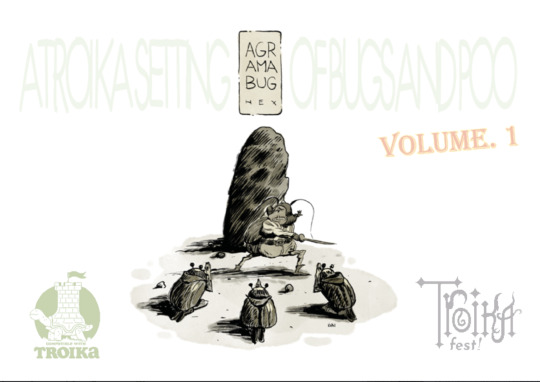


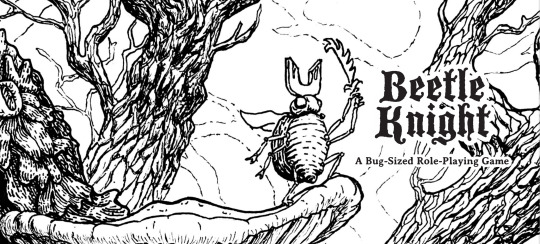
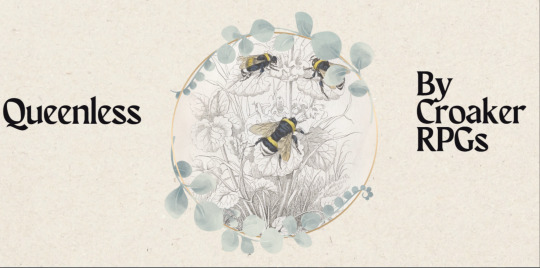
Agramabug Hex, by Volpe80.
Have you spent your whole life dreaming about what it would be like to be an insect? To crawl across the floor for a handful of breadcrumbs and a few shabby spells? To clash with the dictates of your religion that is incompatible with the very survival of your species? To trade every amenity you’ve collected in sweat and blood for precious human poo? Well, if that’s what you dream of, I may have something for you!
This is a supplement for Troika that includes a number of buggy backgrounds to choose from, as well as a bug-themed adventure. You’ll need the Troika rulebook in order to play, which is a really kooky ruleset primed for easy character creation and generative adventures.
Depending on the pace of your group, Agramabug Hex may last for a short campaign, with a small hex map for your little bugs to travel all over, and a random village generator to help you populate the map as you go a-traveling. I don’t know how much bug bureaucracy exists in this little world, but the hardscrabble fight of the various bugs for the scraps of human garbage certainly sounds like a conflict that you can throw all of your legs and mandibles into.
Hive & Hill: A Tale of Two Queens, by thebigtabletop.
Long have the insects warred amongst each-other. Hive and hill rarely see eye to eye. Both sides have suffered innumerable losses when war breaks out and prefer to keep their domains separate. Hives rule the skies and hills rule the earth. A singular threat to their way of life binds them together…
Humans have spread across the world forcing the insects into smaller and smaller pockets of the world. Their size and chemicals make them a great threat. While insects are small, they greatly outnumber the humans. In rare moments, the insects are willing to band together to fight the threat.
Upon a checked ground of red and white gingham, the humans have laid a bounty of food. A veritable feast that they seek to consume. While insects on both sides spend a majority of their time seeking out food, even a small sample of the meal that the human’s call a “picnic” would help feed a hive or hill for the long winter. At this moment, both hive and hill have agreed to work together to get the bounty and drive off the humans.
This is a game all about alliances in times of attrition, but placed on a battlefield distanced from human conflict. You use pools of dice to determine how successful each queen is in her manoeuvres, and role-play through blunders and connections between two sides of the field.
Overall I think this game is a bit closer to a board-game or dice game than a typical ttrpg, although the premise might be something that you can take and run with. If you want a collaborative, team-based game, you might want to take a look at Hive & Hill.
Bug Dish: Amuse Bouche, by The One True Ryan Khan.
Bugfolk from every reach come to Tower Lake at least once. You might be here to see the port city of Tower Point, or the golden hives of Honeyflow. Perhaps you’ve come to wander the paths of woven roots in Banyan Cradle, or to circle the lake on the Gossamer Rail.
But you are certainly here to taste the foods of Tower Lake’s Mobile Kitchens. Restaurant crews who travel around the lake creating culinary experiences. Fusing flavours, textures, and aromas with vision to create delectables no bugfolk has tasted before. Whether it’s a traditional dish perfectly executed, or a meal that changes how you think about food, these chefs are masters of their craft.
Bug Dish is a tabletop roleplaying game about bug chefs who travel the world and compete in culinary competitions. Using a bespoke push-your-luck mechanic, spend time to learn about the local cuisine, find out what your rivals are up to, and create meals to wow the judges.
This is a charming little game that casts your bugs as top chefs, tasked with learning the tastes of cantankerous judgy NPCS in preparation for a big cooking competition. I don’t own this game, but judging by the little teasers on the storefront page, your adventures will include various locations to visit and interesting ingredients to harvest in the pursuit of creating the perfect dish. If you prefer to solve your problems with a saucepan rather than a sword, this might be the game for you.
Beetle Knight, by Brooklet Games.
Beetle Knight is a bug-sized role-playing game for your tabletops. It features "contest rolls" where two creatures, or a creature and the arbiter roll dice against one another to determine uncertain outcomes.
The quickstart for this game starts with a short list of intriguing mysteries that your little characters might find themselves engaging with; from disappearing flies to a water skater trade embargo, to a sudden reticence amongst the court of the Orb Weaver queen. The problems that plague the insect kingdom call for a coterie of buggy knights, called to go where most dare not go!
This game feels heavily inspired by Hollow Knight, and asks the players and GM to engage with contests with e/o every time the Beetle Knights face up against an obstacle. Depending on the foe, this could make play very challenging. Your characters also have a magical resource called Resolve, which can be gained when you roll ties and spend when you want to use the magical items that your knight carries.
The game underwent some fundraising on Kickstarter a while back; there’s no official release of the game yet, but you can still download the Quickstart version of the game if you like. If you want a game with all the fantastical fixings, I recommend Beetle Knight.
Queenless, by Croaker RPGs.
Our Queen is dead! Such sorrow and despair! Without our Queen, our hive, our home, will slowly perish. Our only hope, our only slim hope, is to find, beg, borrow and steal enough Royal Jelly from our neighbours. If we have enough Royal Jelly, maybe, just maybe, we can raise another Queen.
In Queenless you’ll explore the valley, meeting other insects along the way. Your aim is to recover six jars of royal jelly, which your hive will use to raise another Queen. Some insects are friends, such as the Ants who share much in common with the Bees. But some are deadly foes, like the Praying Mantis, who would like nothing more than to eat you up little Bee.
Queenless is built as a solo game from the start with tables, exploration, and other mechanics that will keep you interested and challenge your little bee as it explores the valley on its quest. The core mechanic is based on Firelights, where you use a deck of standard playing cards and dice to determine success, partial success, or failure. You flip two cards and compare them to a dice roll+stats. Easy to figure out and resolve.
If you want a solo game about exploration and survival, but also bargaining with a number of other insects as you search for the things you need in order to raise another queen. Using the Firelights system, you’ll need a deck of playing cards to draw from, using the values of the cards against the results of your dice rolls to determine whether or now you succeed, and whether it will cost you anything to do so. If you want a game that can be be played at the comfort of your own pace, without the constraints of a group, I recommend Queenless.
You might also be interested in…
My Bee Games recommendation post.
This quick Bug Knights recommendation list.
51 notes
·
View notes
Text
Thinking about different eggs between the different alien f/os on here
Dilf f/o and alien one are suppose to be the same species/same f/o so their eggs are the same,
they're maybe the size of large chicken eggs but have a bit of a give to them that let's them pop in a bit more easily, when they're still in this softer state they're a deep blue color, and if you were to hold one in your hand it would have a gel like consistency,
he lays around 4 to 6, the eggs actually will stick together in the womb and end fusing together so despite multiple eggs being laid it's actually normally only 1 baby that's born because it just kinda absorbs the others,
it's an egg birth and you have to birth a bigger egg than what you had going in you, it's shell is more solid now like you'd expect and a lighter blue color,
it's not an easy birth but it's not a hard one either, baby stays in the egg for a little while after being born and has to be kept warm and will hatch on it's own
Alien two
They're a type of fish alien that grows rapidly and try to produce as many children as possible for best odds of survival so their eggs are suited to that
The eggs are small and almost jelly like but surprisingly resilient, maybe the size of a boba or slightly bigger, the smallest clutch there's ever been is just over 30, but they average around 50 eggs at minimum
They don't get much bigger or fuse or anything so birthing them is pretty easy, you just sit in some shallow water maybe a pond in a cave somewhere and they roll out almost effortlessly, unlike alien one instead of staying in the egg once in the water the eggs start hatching nearly immediately leaving a bunch of small ones
You leave the small ones in the pond for about a week while they grow, sadly (or maybe thankfully) the whole clutch won't make it so when you go back for the babies there aren't nearly as many left
Four arm alien
Somehow perfectly round, has the biggest eggs out of all of them, easily around the size of your fist, the shells are hard not so much that if you dropped them they wouldn't crack but they can take a few hits
His kind lay eggs in batches of threes, so it's either 3 eggs, 6 eggs, or a max of 9 eegs
These guys actually hatch while still in you and how many make it depend on the sexes of the babies, the reason they lay batches of 3 at a time is so if there's more females than males (or vice versa) they actually cannibalize in the womb, so if you have two girls and a boy they will eat their brother so resources are spent on making healthy girls instead, cannibalism stops outside the womb though so if you have a boy later down the line his sisters won't try to eat him
This means unless all the eggs end up being the same sex you probably won't birth the full 3,6,9 whatever
Despite how big they grow they're kinda skinny, the biggest things about them their heads (xenomorph looking ass things),
13 notes
·
View notes
Note
What was life like for Jack when Romeo decided to make the “ultimate champion?” 🐉 (specifically during training and after Romeo was defeated)
Well, the training SUCKED dude.See, Romeo is able to fuse two spawn eggs together to create a hybrid mob. However, Jack and the Dragon were already alive. There's no spawn eggs to fuse. Did this deter Romeo? HELL NO he's the admin he can do whatever the heck he wants, so he just. Ripped Jack in half and fused his hips to the base of the dragon's neck. Which, naturally, isn't the most comfortable situation. Other than the mental stress, Jack suffers from a lot of aches, pains, and is incredibly clumsy. I mean, he's HUGE. He's constantly tripping over his tail, knocking stuff over, he has clocked Nurm in the face with his horns quite a few times. He had to relearn how to do a lot of things, like walking, fighting etc. Plus, he is very clearly cut between dragon and human, these two species don't really blend together well. For example, one thing Romeo was dead set on having Jack do is spit acid like his Ender Dragon did. Unfortunately, when Jack tried to do this he burnt his throat very badly as it wasn't tough enough to withstand the dragon's breath. Jack was also constantly being bullied by Romeo. See, Romeo had super high expectations of him, not only because of Jack's great reputation, but also from the dragon. So, when Jack DIDN'T immediately bounce back from the trauma of being torn apart and put back together, Romeo berated him. He was often told that he was weak, pathetic, a failure, and that his friends had likely given up on him. He was often compared to the first dragon. The constant verbal abuse didn't help with his mental health at all.. After he escaped, it took a while for him to get used to having friends again, and he is very paranoid that what Romeo said is true. Also, time flows very differently in Terminal Space than it does in the real world. While only a day or two passed for Jesse, years passed for Jack. He was dealing with this for much longer than Jesse could imagine. All of these things combined to create a Jack who struggles to trust anyone. Romeo successfully brainwashed him into thinking he had no one, and while this backfired and Jack fought back in the institute, he is still much more distant and very defensive.
Now, after Romeo was defeated, Jack's life struggled to go back to normal. For starters, he's part Dragon now. It took quite a while for the town to get used to that. Eventually, most people relaxed to the sight of him and many find his presence comforting (who the hell is crazy enough to bother the town NOW, they have a huge dragon warrior champion protecting them), but a lot of people are still terrified of him. Also, he can't fit inside the emporium at all anymore. Actually, he's almost the same size as the shop, so he and Nurm had to move to a much bigger place just outside of town. He is, of course, not happy about this. He loves that little shop, but it can't be helped. A lot of little things were impacted, he can't even go anywhere without being watched constantly anymore. He tries not to visit other towns too often as he knows he will frighten other people. He still struggles a lot mentally, he is convinced that he is a horrible, unlovable monster, but Nurm slowly helps him lose this idea. Also, because he was alone with Romeo for so long, he forgets that some things aren't normal. Like, he sheds his scales every so often, but he forgot to tell anyone so one day Nurm came home to Jack sat in a pile of his own skin like 🙂 He didn't realize how unsettling that is to everyone..It's not all bad though. I mean, he can fly now. That's pretty awesome. The elytra gets a lot more use now as he and Nurm like to fly around the mountains and forests together. He has always been very protective of his friends and now just his presence is enough to deter most things that want to hurt them. Also, endermen LOVE Jack. They often follow him when he and Nurm go traveling, just.. watching him from a distance. Sometimes they'll leave blocks for him like crows. Honestly, most mobs just leave him alone now. They know better than to anger the giant dragon guy. Jack is much stronger, so he can carry way more than he did previously too and they manage to rebuild a better (and much bigger-) Emporium together.

Also have a doodle 😛
#minecraft story mode#mcsm#mcsm jack#jack mcsm#Mcsm au#Want to draw that one “pigeon gazes lovingly at his gigantic angry wife” picture as these two so badly..#Also to the person who said anyone who messes with Nurm is fucked? Couldn't be more right dude.#Chimera champion au
14 notes
·
View notes
Note
Might be a weird question, but you know how humans tend to anthropomorphize animals and objects and such like in fiction?
Either by just giving them human language and thoughts, or by also making the animals/objects stand on two legs or an upright pose and more human like anatomy in the case with furries and such?
Or even give themselves features of animals like my sona with deer ears and legs and a long tail and such?
Or in ancient Egypt with the depictions of gods with animal heads
Or heck even just furries and fursonas
On Bolur, in any era, do the homo mousike ever anthropomorphize animals or objects in their art and stories? How would a Debu/Zebraman/elf fursona look like? How would they visually anthropomorphize other things in their art and stories?
I think about these things sometimes (when it comes to alien life/spec biology in general)
OOOOH. I LIKE THIS QUESTION A LOT.
So first: Yes, they anthropomorphize their animals and objects! Definitely now when their collective histories just began, but especially so in Zebraman culture all throughout their history, when their entire lives are centered around their animals (recent update, I need to flesh it out). Just about every zebraman god is animal-based because of it, and zebramen have way more societies focused on stewarding the land and its animals.
Debu anthropomorphize objects slightly more than other homo mousike - when nothing around you is your size, you relate to the things that are, and generally those things were the things made for you. They give them faces and have these masks or collective objects dedicated to concepts or people, or a particular figure is embued with a spirit of their own.
As for fursonas...
Ok, here on out, I'm gonna be calling them pycnofiberies, since everything here will be based on the night cloe. This is the debu Dog so I think this is a good candidate for furry-ization, and just for simplicity I'll use the night cloe for the zebrapeople anthros, too.

So, first thing off the bat - the most obvious anthromorphization for debu is sizing everything to their just like we do, it's just more obvious now that they're huge. The front teeth are usually really bunched together and seperate from the others on Bolur and while fusing together into beaks or tusks is common, the teeth are often seperate, like they are in night cloes. Debu often fuse them together to make them resemble tusks more ( since gaps in teeth are kind of uncanny to them) and add a beard, even if it's just stubble to their anthros, the same way we add our hair. They also add a mouthglow! In cartoons, Debu mouthglows sometimes are neon colored rather than just white as an exaggeration of the minute color differences in actual mouthglows, either to tell apart individual debu, as stylization or to be more obvious to the yellow-blue colorblind zebrapeople. (which is why yellow and green dyes are so rare - the species that develops the most dyes don't percieve greens and yellows very well.)
Also, a hump, in the same way we add boobs to everything regardless of the boobage in the actual animal. Humps in debu are attractive in both sexes, and are usually added regardless of the intent on making a character attractive.
And of course, for expressions, the nostrils are exaggeratedly large, no matter what animal it's on.

There's also the exaggeration of facial discs in night cloes the same way ears are in our furries, sometimes so extreme the edges jut out from the face. There's also a feature in a lot of "mary sues"/"gary stus" where the claws are overgrown - in Debu cultures, gods are often depicted with overgrown, curved hooves to demonstrate their age and "mythical-ness", as it's an occurrence in elderly debu but not a very common one. So, to show power, alongside a brightly glowing mouth, mary sue cloesonas have great, curved claws. There's also the "beastars" style hands, where they'll give their hooved hands to animals with little other animalistic detail.

Then there's cloe-girls and "angels"
Debu recognize facial discs as the ears of a cloe, but don't put them at their ears, they put them at the same place they see them - around the eyes. They have the same catgirl ear inaccuracies as us!
There's also angels, winged debu. They have the same gig as us where they just slap cloe wings on there without regard to homologous structures.

Now onto zebrapeople anthros!
Zebramen do the same thing as us, making their pycnofiberies stand on 4 or 6 legs rather than all 6 or 8 (depending on the -pedalism). Zebraelves though, as they are equally hexapodal as they are octopodal, do a mix of both, sometimes relating to sex - "drone" and "queen" pycnofiberies (they project their genders/sexes onto non-eusocial animals too) are often more hexapodal than their worker counterparts, as queen zebraelves are sometimes restricted to hexapodality on account of sometimes being too gravid to walk on all 8's, and drones just generally being found on cloeback or on the ground, where zebraelves usually assume a hexapodal posture. "Taurs" are also very common.
There's also the arm situation when it comes to night cloes specifically, because cloes generally have "plantigrade" forearms, while zebrapeople have "digigrade" forearms; their arm appears to have a second joint. Just like how we deal with digigrade legs in our furries, pycnofiberies have it either-or.

So - this is corny? (just because of the focus on stripes, the one thing that zebras are known for) but a beauty/aesthetically pleasing convention in zebrapeople is the "stripe continuation" comparable to how we like facial symmetry. It's attractive to them to have... geometric integrity with their stripes, which is why monobrows are seen as more attractive than broken brows. It's more exaggerated in zebraelves because their black and white stripes are more common, and they serve more of a purpose than they do in zebramen. Following this, cartoon zebrapeople's faces often are depicted with very simplistic X's, swooping stripes, or are made with "one line". So, abiding by toony laws, so are their pycnofiberies!
Their pycnofiberies have their eyebrows either following or coming off from a continued line, and their lip/nasal area is generally colored black, too, or the color of whatever follows the line. Night Cloes must be super common pycnofibersonas for zebrapeople the same way wolves are common fursonas, because wowza those facial discs follow stripe continuation really nicely.

(sidenote: i think zebrapeople would CONSTANTLY have weird looksmaxxing fads relating to the the geometric integrity of their stripes too, the same way looksmaxxing circles started fretting about canthal tilts and shit. it would get racist fast. just like us :') )
And, they do cloe-girls and angels the same way as us.

#ntls-24722#ask#homo mousike#furry ergonomics#furry#speculative biology#speculative evolution#speculative worldbuilding#speculative fiction#dj music man#djmm#fnaf djmm#djmm fnaf#music man#fnaf music man#music man fnaf#(almost) daily music man#fnaf dj music man#dj music man fnaf#artastic-friend
22 notes
·
View notes